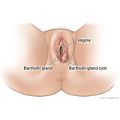Condition Basics
What is a Bartholin gland cyst?
Bartholin glands
The Bartholin glands are two small organs that are located on each side of the vaginal opening. Most of the time, you can't feel or see these glands.
The Bartholin glands make a small amount of fluid to lubricate the vagina and the vulva. This fluid comes out of two tiny tubes next to the opening of the vagina. These tubes are called Bartholin ducts.
Bartholin gland cyst
If a Bartholin duct gets blocked, fluid builds up in the gland. The blocked gland is called a Bartholin gland cyst. (Sometimes it's called a Bartholin duct cyst.) These cysts can range in size from a pea to a large marble. They usually grow slowly. If the Bartholin gland or duct gets infected, it's called a Bartholin gland abscess.
Bartholin gland cysts are often small and painless. Some go away without treatment. But if you have symptoms, you might want treatment. If the cyst is infected, you will need treatment.
What causes it?
Things like thick mucus or swelling can block a Bartholin gland duct and cause a cyst. The cyst can get bigger after sex, because the glands make more fluid during sex.
Infected Bartholin cysts are sometimes caused by sexually transmitted infections (STIs). You can lower your risk of STIs by using a condom when you have sex.
What are the symptoms?
You may not have any symptoms if the Bartholin gland cyst is small. But a large cyst or an infected cyst (abscess) can cause symptoms.
Symptoms of a cyst that is not infected include:
- A painless lump near the opening of the vagina.
- Discomfort when you walk, sit, or have sex.
Symptoms of an infected cyst include:
- Pain that gets worse and makes it hard to walk, sit, or move around.
- Swelling or redness on the vulva.
- Drainage from the cyst.
- Fever.
How is it diagnosed?
You may find a Bartholin gland cyst on your own, or your doctor may notice it during a physical exam. Unless it is causing symptoms, you may not know you have one.
An abscess is diagnosed based on signs of infection, such as fever or swelling, and pain in the vulva area.
In some cases, especially if you are older, your doctor may biopsy the cyst to make sure that it isn't cancer or another problem.
How is a Bartholin gland cyst treated?
Some Bartholin gland cysts go away without treatment. You can take a nonprescription pain medicine such as ibuprofen (Advil or Motrin, for example) to relieve mild discomfort. To help healing, soak the area in a shallow, warm bath, or a sitz bath. This can help a cyst drain and heal on its own.
If the cyst is infected, large, or painful, you may need other treatment. Your doctor may need to drain the cyst. If it's infected, you may also need to take antibiotics.
To keep the cyst from closing and filling up again, your doctor may put a small drainage tube with a small balloon at one end inside the cyst. The balloon is inflated inside the cyst to keep the cyst open. After the gland has healed, the tube and balloon are removed. Or you may have a procedure to create a pouch that allows the cyst to drain. This is done by making a cut over the cyst and stitching the sides together.
Sometimes a carbon dioxide laser or silver nitrate is used to prevent a cyst from growing back. For severe cysts that keep coming back, you may have surgery to remove the Bartholin gland and duct.

